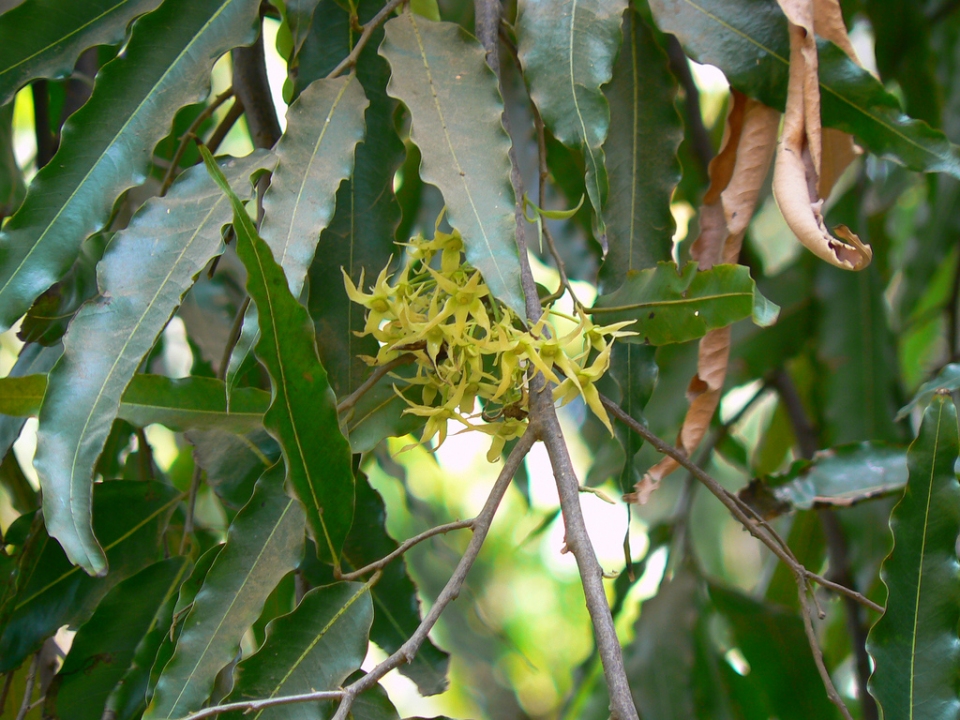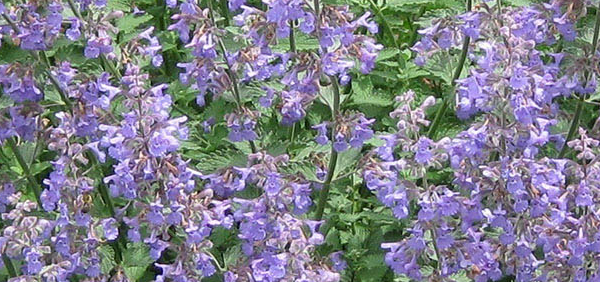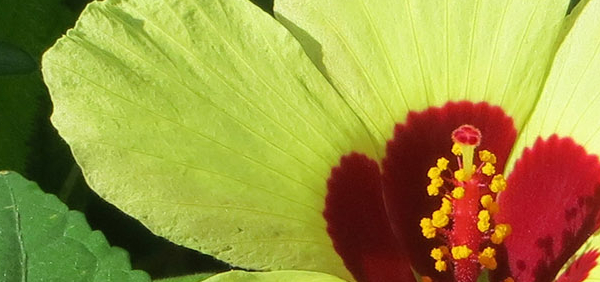ulkata :
 Polyalthia longifolia, the false ashoka native to India, is a lofty evergreen tree, commonly planted due to its effectiveness in alleviating noise pollution. It exhibits symmetrical pyramidal growth with willowy weeping pendulous branches and long narrow lanceolate leaves with undulate margins. The tree is known to grow over 30 ft in height.
Polyalthia longifolia, the false ashoka native to India, is a lofty evergreen tree, commonly planted due to its effectiveness in alleviating noise pollution. It exhibits symmetrical pyramidal growth with willowy weeping pendulous branches and long narrow lanceolate leaves with undulate margins. The tree is known to grow over 30 ft in height.HISTORICAL AND MYTHOLOGICAL REVIEW:
The False ashoka was cultivated and gained popularity in British India for nostalgic reasons because it resembled the Mediterranean cypress, and also in order to be used to make ship mastsTaxonomical Classification
Kingdom: Plantae - Plants
Subkingdom: Streptophyta
Superdivision: Spermatophyta - Seed plants
Division: Magnoliophyta - Flowering plants
Class: Magnoliopsida - Dicotyledons
Family: Annonaceae
Genus: Polyalthia
Species: Polyalthia longifolia
Allied species:
VERNACULAR NAMES
Sanskrit: Ashoka, PutrajivaEnglish: mast tree, cemetery tree false ashoka, the Buddha tree, Indian mast tree, and Indian fir tree.
Hindi: Debdaru
Urdu: الٹا اشوک
Telugu: Ashoka, ashokamu, asodham, asoka, asokam, asokamu, asvattamu, asvatthamu, daevadaaru, devadaru, nara mamidi, naramaamidi, nettlingum
Bengali: Debdaru
Marathi: Ashok
Konkani: Asok
Oriya: Debodaru
Gujarathi: Asopalav
Tamil: Nettilinkam நெட்டிலிங்கம் Vansulam
Malayalam: araNamaram: അരണമരം
Kannada: Ubbina
Assamese: (উনবৈ) or Debadaru (দেৱদাৰু)
Chinese: She-kan
French: Faux ashoka
Nepal: Nwakali ashok
Sinhalese: Owila
Varities:
There are two varieties in cultivation. The more striking, var. pendula, has a straight slim trunk and short branches that droop, resulting in a narrow columnar shape not usually seen in tropical trees. The less common variety, var. angustifolia, has branches that are more wide-spreading, forming a pyramidal crown. The bark is grey and smooth.Definition
Polyalthia is derived from a combination of Greek words meaning ‘many cures’ with reference to the medicinal properties of the tree while Longifolia, in Latin, refers to the length of its leavesSynonyms
Synonyms in Ayurveda: ulkata, kashtadaruRasa: Katu Tikta
Guna: Laghu Ruksha
Veerya: Ushna
Vipaka: Katu
Karma: Depana Jwarahara-useful in fever, Kaphahara Krimighna Kushtagna-useful in skin diseases, Pittahara
antibacterial, antifungal, cytotoxic, antiulcer, hypotensive, laxative, anti-inflammatory properties
Cultivation:
It performs best on sites with full to partial sun exposure and on rich, free-draining clay-loam, loam, sandy-loam and loamy-sand soils of a slightly acid to neutral nature, generally with a pH of 5.5 to 7.5. Young plants need protection from winds, especially under hot, dry conditions but once established have good tolerance to drought.Propogation:
Harvesting:
Most germinate within two to three weeks and the young seedlings cared for in a nursery for around a year before being planted out. Care should be taken when transplanting to not damage the delicate roots.Phytochemistry:
Parts used for medicinal purpose
Bark, Leaves, ,Dosage:
The decoction is taken in a dose of 50-100 ml in a day.Substitute:
False Ashok tree, is wrongly equated with the name Asoka by some, and is often used as a substitute or as an adulterant to the genuine Asoka bark. But it is not advisable to use false Ashok as substitute of True Ashok. It is completely different from true Ashok tree, which is Saraca asocaControversy:
Commercial value:
It is very effective in reducing noise pollutionMorphology:
An evergreen tree with a straight trunk, conical crown and slender drooping branches, about 10-25 m tall. Bark dark grayish brown, branches sparsely puberulous when young, glabrous when mature. Leaves simple, alternate, narrow lanceolate or linear lanceolate, 15-25 x 2-4 cm across, base slightly acute or cuneate, margin wavy or undulate, apex long acuminate, membranous, coriaceous, faintly aromatic, shining dark green, glabrous above, paler glaucous beneath, lateral veins 25-30 on either side of the midrib, impressed above, prominent on the midrib beneath, very slightly on the veins beneath, reticulate veinlets fine and close, petiole pubescent, about 0.8-1.5 long. Flowers bisexual, axillary, solitary or fascicled on very short umbels from axils of fallen leaves, yellowish green, about 2.5-3 cm long, pedicels slender, tomentose, about 1-1.5 cm long, bracts submedian. Sepals 3, broadly ovate or triangular, base connate, apex acute, pubescent, about 1-2 x 1-1.5 mm across. Petals 6, in 2 series, valvate, outer petals, slightly narrower than the inner petals, lanceolate, base broad, apex acuminate, yellowish green, fleshy, glabrous inside, about 6-7 x 2 mm across, inner petals base broader than outer petals, about 10-15 x 2.5 mm across. Stamens numerous, about 1 mm long, anthers broad, dorsal, connectives convex flat on top. Carpels many, base slightly broad, linear, puberulous, stigma sessile. Ripe carpels, subglobose or ellipsoid monocarps, obtuse at base and apex, green when young, dark purplish black when ripe, about 2 x 1 cm across, stalk stout, about 1-1.5 cm long, Seeds 1, pale brown to light brown, longitudinally grooved, ovoid.Histology:
Geographical distribution:
Found natively in India and Sri Lanka. It is introduced in gardens in many tropical countries around the world. It is, for example, widely used in parts of Jakarta in Indonesia and the Caribbean islands of Trinidad and Tobago.ECOLOGICAL ASPECT:
It does not require pruning in order to maintain its tall, straight, main trunk with short, drooping branches.Plant conservation:
LC (NCS)-2012General Use:
In traditional medicines various herbal preparations are being used for treating dueodenal ulcers. The plant has been used in traditional system of medicine for the treatment of fever, skin diseases, diabetes, hypertension and helminthiasis.Therapeutic Uses:
It has bitter, acrid, cooling, febrifuge, and anthelminthic properties. In many parts of India, it is used for treating fever, mouth ulcers, rheumatism, menorrhagia, scorpion sting, diabetes, vitiate conditions of vata, and pitta, and skin disease. The bark is given to treat excessive mensuration, and white discharge.Systemic Use:
The pulp of flowers is used as a remedy for dysenteryAdministration:
DecoctionPharmacological:
Polyalthia longifolia is a versatile plant which is used to treat rheumatism, menorrhagia, scorpion sting, diabetes, skin disease, hypertension, helminthiasis and also in treatment for the digestive systemClinical trials:
Research:
Precautions:
Seek medical guidance for use during pregnancy and lactationToxicity studies:
The toxicological studies done on Fake Ashok shows, acute oral administration of the leaf is not toxic, and safe in a single dose. The concluded that crude powder, and the extracts of P. longifolia leaf are considered as safe in acute condition up to 3.2 g/kg dose level.Use in other system of medicine:
CONCLUSION:
Photos of ulkata -
Polyalthia longifolia
- Courtesy: http://tropical.theferns.info/plantimages/9/e/9e9daa49d73868954f499fd161e18f4211dc1c92.jpg
- Courtesy: http://tropical.theferns.info/plantimages/e/5/e58115c44bc878a4da453d4b8ac2e46362900a1e.jpg
- Courtesy: http://tropical.theferns.info/plantimages/4/4/44e94b75356af766236d4e92386975d1739dda29.jpg
- Courtesy: http://tropical.theferns.info/plantimages/e/5/e58115c44bc878a4da453d4b8ac2e46362900a1e.jpg
- Courtesy: https://en.m.wikipedia.org/wiki/Polyalthia_longifolia#/media/File%3AAshoka_(Polyalthia_longifolia)_flowers_W2_IMG_7047.jpg
- Courtesy: https://en.m.wikipedia.org/wiki/Polyalthia_longifolia#/media/File%3APolyalthia_longifolia_var_pendula_-_leaves_1.jpg
- Courtesy: https://en.m.wikipedia.org/wiki/Polyalthia_longifolia#/media/File%3AAshoka_(Polyalthia_longifolia)_flowers_W2_IMG_7047.jpg
- Courtesy: http://www.asergeev.com/pictures/archives/2015/1589/jpeg/11b.jpg
- Courtesy: http://plantillustrations.org/illustration.php?id_illustration=148027&SID=9v8h6k4k9ksihush69mup6c4k6&mobile=2&code_category_taxon=9&size=1
- Courtesy: https://en.m.wikipedia.org/wiki/Polyalthia_longifolia#/media/File%3AAshoka_(Polyalthia_longifolia)_flowers_W2_IMG_7047.jpg
- Courtesy: http://plantillustrations.org/illustration.php?id_illustration=193073&SID=9v8h6k4k9ksihush69mup6c4k6&mobile=2&code_category_taxon=9&size=1
- Courtesy: http://plantillustrations.org/illustration.php?id_illustration=193073&SID=9v8h6k4k9ksihush69mup6c4k6&mobile=2&code_category_taxon=9&size=1
KEY WORDS: ulkata, false asuka tree, Polyalthia longifolia
- » Classification and names of ulkata
- » Synonyms and definitions of ulkata
- » Drug Properties of ulkata
- » Chemical Constituents of ulkata
- » Standardization of ulkata
- » Parts used and Dosage of ulkata
- » Morphology and Histology of ulkata
- » Distribution and Conservation of ulkata
- » Cultivation of ulkata
- » ulkata in the market
- » Medicinal Uses of ulkata
- » Researches and clinical trails of ulkata
- » ulkata in other sytems of medicine
- » Ayurvedic formulations with ulkata
- » Images of ulkata

Kotakkal Ayurveda - Mother land of modern ayurveda























